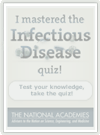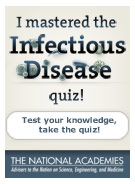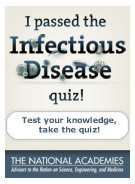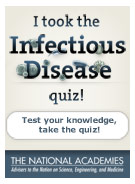
What You Need To Know About Infectious Disease
What do you know about infectious disease?
True or False: Our bodies contain at least 10 times more human cells than bacterial cells.
-
Sorry, that’s incorrect.
Our bodies contain at least 10 times more bacterial cells than human cells.
-
Correct!
Our bodies contain at least 10 times more bacterial cells than human cells.
Roughly how many microbes live in the human gastrointestinal tract?
-
Sorry, that’s incorrect.
About ten trillion microbes live in the human gastrointestinal tract. They are essential for proper digestion and absorption of nutrients.
-
Sorry, that’s incorrect.
About ten trillion microbes live in the human gastrointestinal tract. They are essential for proper digestion and absorption of nutrients.
-
Sorry, that’s incorrect.
About ten trillion microbes live in the human gastrointestinal tract. They are essential for proper digestion and absorption of nutrients.
-
Correct!
About ten trillion microbes live in the human gastrointestinal tract. They are essential for proper digestion and absorption of nutrients.
Since the beginning of the 20th century, the number of people in the world has:
-
Sorry, that’s incorrect.
Since the beginning of the 20th century the number of people in the world has more than quadrupled—from 1.6 billion to nearly 7 billion—and world population is expected to rise to well over 9 billion by 2050.
-
Sorry, that’s incorrect.
Since the beginning of the 20th century the number of people in the world has more than quadrupled—from 1.6 billion to nearly 7 billion—and world population is expected to rise to well over 9 billion by 2050.
-
Correct!
Since the beginning of the 20th century the number of people in the world has more than quadrupled—from 1.6 billion to nearly 7 billion—and world population is expected to rise to well over 9 billion by 2050.
About how much of its fish and seafood does the United States import?
-
Sorry, that’s incorrect.
The United States imports more than 80 percent of its fish and seafood. About 20 percent of its fresh vegetables and 50 percent of its fresh fruits are imported. As wealthy nations demand such foods year-round, the increasing reliance on producers abroad means that food may be contaminated during harvesting, storage, processing, and transport—long before it reaches overseas markets.
-
Sorry, that’s incorrect.
The United States imports more than 80 percent of its fish and seafood. About 20 percent of its fresh vegetables and 50 percent of its fresh fruits are imported. As wealthy nations demand such foods year-round, the increasing reliance on producers abroad means that food may be contaminated during harvesting, storage, processing, and transport—long before it reaches overseas markets.
-
Correct!
The United States imports more than 80 percent of its fish and seafood. About 20 percent of its fresh vegetables and 50 percent of its fresh fruits are imported. As wealthy nations demand such foods year-round, the increasing reliance on producers abroad means that food may be contaminated during harvesting, storage, processing, and transport—long before it reaches overseas markets.
Which of the following is an effective way to protect yourself against infectious disease?
- Keep immunizations up to date
- Wash your hands often
- Prepare and handle food carefully
- All of the above
-
Sorry, that’s incorrect.
All of the above can help prevent infectious disease. Other behaviors, such as exercising caution around wild and unfamiliar domestic animals, avoiding insect bites, practicing safe sex, and being vigilant about disease threats while traveling abroad, can also reduce the risk of infection.
-
Sorry, that’s incorrect.
All of the above can help prevent infectious disease. Other behaviors, such as exercising caution around wild and unfamiliar domestic animals, avoiding insect bites, practicing safe sex, and being vigilant about disease threats while traveling abroad, can also reduce the risk of infection.
-
Sorry, that’s incorrect.
All of the above can help prevent infectious disease. Other behaviors, such as exercising caution around wild and unfamiliar domestic animals, avoiding insect bites, practicing safe sex, and being vigilant about disease threats while traveling abroad, can also reduce the risk of infection.
-
Correct!
All of the above can help prevent infectious disease. Other behaviors, such as exercising caution around wild and unfamiliar domestic animals, avoiding insect bites, practicing safe sex, and being vigilant about disease threats while traveling abroad, can also reduce the risk of infection.
True or False: Not all microbes are harmful to humans.
-
Correct!
Not all microbes are harmful to humans. In fact, many of them protect us, helping our bodies function properly and competing with harmful organisms in an eternal contest for habitable space in or on our bodies. Although the microorganisms that cause disease often receive more attention, most microorganisms do not cause illness.
-
Sorry, that’s incorrect.
Not all microbes are harmful to humans. In fact, many of them protect us, helping our bodies function properly and competing with harmful organisms in an eternal contest for habitable space in or on our bodies. Although the microorganisms that cause disease often receive more attention, most microorganisms do not cause illness.
True or False: Infection with a pathogen (a disease-causing microbe) does not necessarily lead to disease.
-
Correct!
Infection occurs when viruses, bacteria, or other microbes enter your body and begin to multiply. Disease follows when the cells in your body are damaged as a result of infection, and signs and symptoms of an illness appear.
-
Sorry, that’s incorrect.
Infection occurs when viruses, bacteria, or other microbes enter your body and begin to multiply. Disease follows when the cells in your body are damaged as a result of infection, and signs and symptoms of an illness appear.
True or False: Most infectious diseases are not impacted by changes in the environment.
-
Sorry, that’s incorrect.
Most infectious diseases are impacted by changes in the environment. Malaria, dengue, and viral encephalitis infections, for example, are highly sensitive to environmental changes.
-
Correct!
Most infectious diseases are impacted by changes in the environment. Malaria, dengue, and viral encephalitis infections, for example, are highly sensitive to environmental changes.
True or False: Growing evidence suggests that infections are behind many chronic diseases once thought to be caused by genetic, environmental, or lifestyle factors.
-
Correct!Growing evidence does suggest that infections are behind many chronic diseases once thought to be caused by genetic, environmental, or lifestyle factors, including peptic ulcers and cervical, liver, and gastric cancers.
-
Sorry, that’s incorrect.
Growing evidence does suggest that infections are behind many chronic diseases once thought to be caused by genetic, environmental, or lifestyle factors, including peptic ulcers and cervical, liver, and gastric cancers.
Thank you for taking our quiz.
Place this badge on your Facebook page to show your friends what you know about infectious disease.
Place this badge on your Facebook page to show your friends what you know about infectious disease.
OR, get a higher score to unlock a different badge.

Place this badge on your Facebook page to show your friends what you know about infectious disease.
OR, get a higher score to unlock a different badge.

Explore Other Topics
Disease Watchlist
Infectious Disease Defined
- Organism
A living being that can reproduce, grow, react to external stimuli, and maintain its internal equilibrium.


